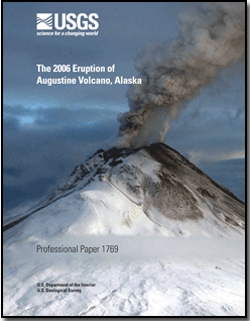The 2006 Eruption of Augustine Volcano, Alaska
Edited by John A. Power, Michelle L. Coombs, and Jeffrey T. Freymueller
2010
Preface

Augustine Volcano, the most historically active volcano in Alaska's Cook Inlet region, again showed signs of life in April 2005. Escalating seismic unrest, ground deformation, and gas emissions culminated in an eruption from January 11 to mid-March of 2006, the fifth major eruption in 75 years. The eruption began with a series of 13 short-lived blasts over 20 days that sent pyroclastic flows; snow, rock, and ice avalanches; and lahars down the volcano's snow clad flanks; ash clouds drifted hundreds of kilometers downwind. Punctuated explosive activity gave way to effusion of lava and emplacement of thick block-and-ash flows on the volcano's north flank that continued through mid-February. In mid-March renewed extrusion resulted in the building of a new, higher summit lava dome and two blocky lava flows on the north and northeast flanks of the cone. The eruption resulted in ash fall on many south-central Alaskan communities and disrupted air traffic in the region.
Augustine's frequent eruptions and relatively easy access have long drawn volcanologists to study the accumulation, ascent, and eruption of andesitic to dacitic magma. Studies of the most recent activity before 2006, in 1976 and 1986, revealed that the volcano lately produces explosive eruptions that are preceded by months of unrest and injection of new magma into a storage region in the upper several kilometers of the crust. Each of these eruptions then followed a similar progression from explosive to effusive behavior over several months. Petrologic and geophysical observations suggest that these three eruptions were triggered by similar magma mixing events and that the subsequent ascent and eruption of magma was governed by processes that were roughly constant from one eruption to the next. Geologic studies of the island show that in the more distant past parts of Augustine's edifice have failed repeatedly, resulting in debris avalanches that entered the sea and, at least once, in 1883, caused a tsunami that hit surrounding Cook Inlet coastlines. Such edifice failures and resultant local tsunamis should be expected in the future.
Read the rest of the preface and download the complete, 684p report here
--
Got Penguins?
Penguin News Today
The Science of Penguins
The Gentoos are back! Come see them on live cam at:
Gentoo Penguins of Gars O'Higgins Station, Antarctica

__._,_.___
No comments:
Post a Comment